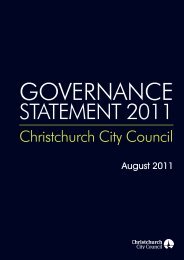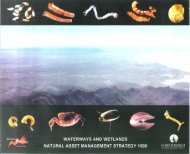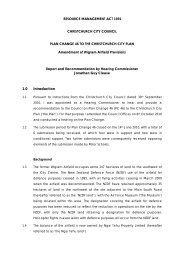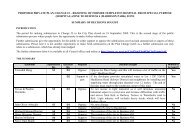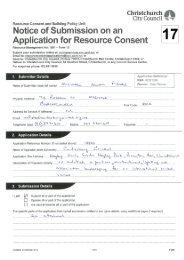Annual Report 2010 - Christchurch City Council
Annual Report 2010 - Christchurch City Council
Annual Report 2010 - Christchurch City Council
Create successful ePaper yourself
Turn your PDF publications into a flip-book with our unique Google optimized e-Paper software.
Statement of<br />
accounting policies<br />
(continued)<br />
Financial statements<br />
<strong>Annual</strong> <strong>Report</strong><br />
<strong>Christchurch</strong> Otautahi<br />
<strong>2010</strong><br />
p149.<br />
Notes to financial statements<br />
1. Statement of accounting policies (continued)<br />
Trade and other receivables<br />
(i) Construction work in progress<br />
Construction work in progress is stated at cost plus profit<br />
recognised to date (see Revenue policy) less a provision for<br />
foreseeable losses and less progress billings. Cost includes<br />
all expenditure related directly to specific projects and an<br />
allocation of fixed and variable overheads incurred in contract<br />
activities based on normal operating capacity.<br />
(ii) Other trade and other receivables<br />
Trade and other receivables are initially measured at fair<br />
value and subsequently measured at amortised cost using the<br />
effective interest method, less any provision for impairment<br />
(see Impairment policy).<br />
Inventories<br />
Inventories are stated at the lower of cost and net realisable value.<br />
Net realisable value is the estimated selling price in the ordinary<br />
course of business, less the estimated costs of completion and<br />
selling expenses.<br />
Inventories held for distribution at no charge, or for a nominal<br />
amount, are stated at the lower of cost and current replacement<br />
cost.<br />
The cost of other inventories is based on the first-in first-out<br />
principle and includes expenditure incurred in acquiring the<br />
inventories and bringing them to their existing location and<br />
condition.<br />
Cash and cash equivalents<br />
Cash and cash equivalents comprise cash balances and call<br />
deposits, and other short-term highly liquid investments with<br />
maturities of three months or less. Bank overdrafts that are<br />
repayable on demand and form an integral part of the <strong>Council</strong>’s<br />
cash management are included as a component of cash and cash<br />
equivalents for the purpose of the statement of cash flows, and in<br />
current liabilities on the balance sheet.<br />
Impairment<br />
The carrying amounts of the <strong>Council</strong>’s assets, other than<br />
investment property (see Investments policy and deferred tax<br />
assets (see Income Tax policy), are reviewed at each balance sheet<br />
date to determine whether there is any indication of impairment.<br />
If any such indication exists, the asset’s recoverable amount is<br />
estimated.<br />
For goodwill, other intangible assets that have an indefinite useful<br />
life and intangible assets that are not yet available for use, the<br />
recoverable amount is estimated at each balance sheet date.<br />
An impairment loss is recognised whenever the carrying amount<br />
of an asset or its cash-generating unit exceeds its recoverable<br />
amount. Impairment losses are recognised through profit and<br />
loss. Impairment losses on revalued assets offset any balance in<br />
the asset revaluation reserve, with any remaining impairment loss<br />
being posted to profit and loss.<br />
Impairment losses recognised in respect of cash-generating units<br />
are allocated first to reduce the carrying amount of any goodwill<br />
allocated to cash-generating units (group of units) and then to<br />
reduce the carrying amount of the other assets in the unit (group of<br />
units) on a pro rata basis.<br />
When a decline in the fair value of an available-for-sale financial<br />
asset has been recognised directly in equity and there is objective<br />
evidence that the asset is impaired, the cumulative loss that had<br />
been recognised directly in equity is recognised in profit or loss<br />
even though the financial asset has not been derecognised. The<br />
amount of the cumulative loss that is recognised in profit or loss<br />
is the difference between the acquisition cost and current fair<br />
value, less any impairment loss on that financial asset previously<br />
recognised in profit or loss.<br />
(i) Calculation of recoverable amount<br />
The recoverable amount of the <strong>Council</strong>’s investments in<br />
receivables carried at amortised cost is calculated as the<br />
present value of estimated future cash flows, discounted at<br />
the original effective interest rate (i.e., the effective interest<br />
rate computed at initial recognition of these financial assets).<br />
Receivables with a short duration are not discounted.<br />
The recoverable amount of other assets is the greater of their<br />
market value less cost to sell and value in use.<br />
As a public benefit entity, <strong>Council</strong> uses depreciated<br />
replacement cost to assess value in use where the future<br />
economic benefits or service potential of the asset are not<br />
primarily dependent on the asset’s ability to generate net cash<br />
inflows and where <strong>Council</strong> would, if deprived of the asset,<br />
replace its remaining future economic benefits or service<br />
potential. For the group, where an asset does not generate<br />
largely independent cash inflows, the recoverable amount is<br />
determined for the cash-generating unit to which the asset<br />
belongs.<br />
The value in use for cash-generating assets is the present value<br />
of expected future cash flows. The discount rate used reflects<br />
current market assessments of the time value of money and the<br />
risks specific to the asset.





